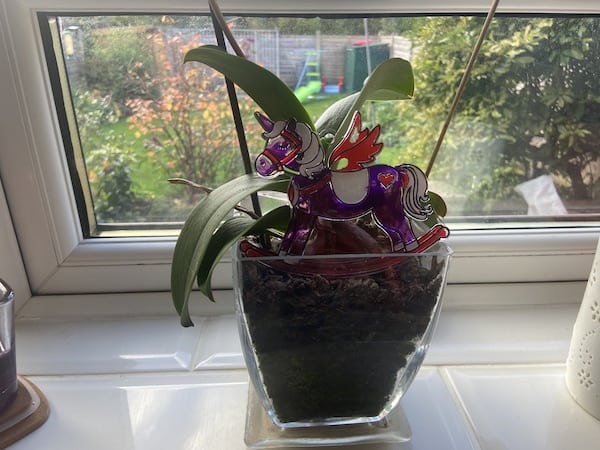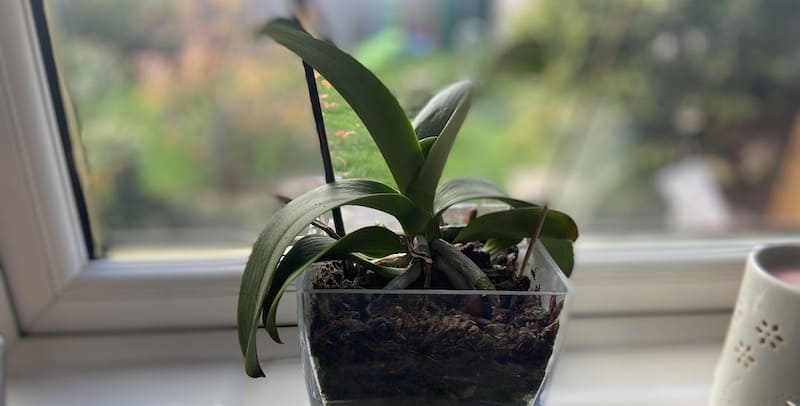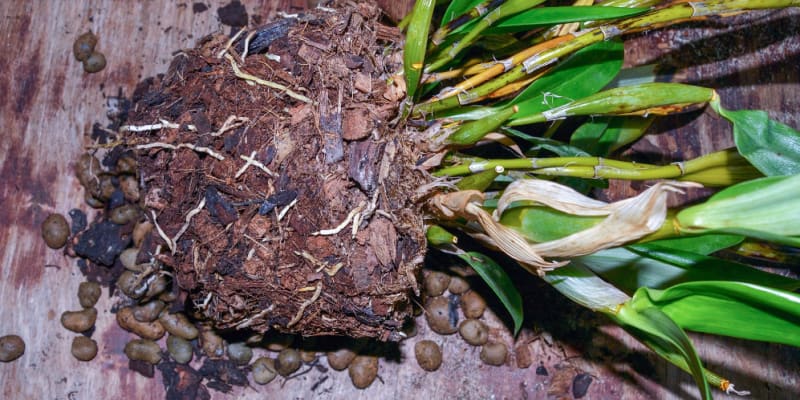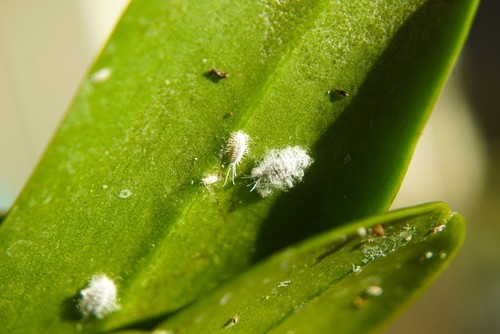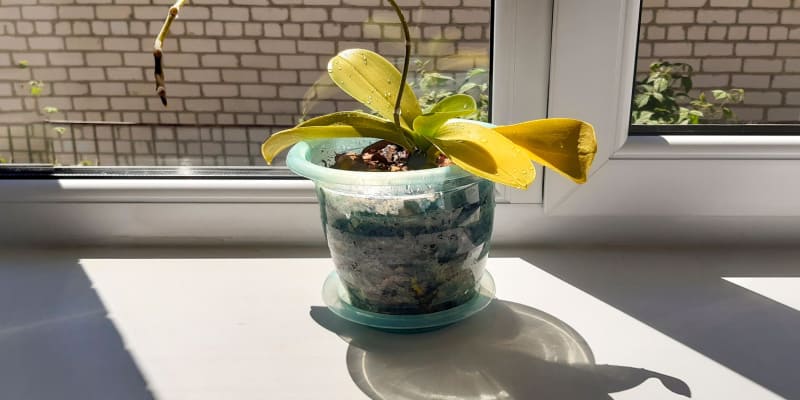
Why are my orchid leaves turning yellow?
Our site is reader supported, this means we may earn a small commission from Amazon and other affiliates when you buy through links on our site.
Figuring out why your orchid leaves are turning yellow is going to take some detective work. Quite a few environmental reasons (e.g. watering, temperature) and some pests and diseases cause this problem with your orchid plant. I also have this guide on why orchid leaves sometimes turn brown. That said, here are the main reasons why this may be happening and what to do about them.
Natural ageing process
First of all, yellow leaves may be a part of the natural ageing process of the orchid. Mature Phalaenopsis orchids have elongated stems at the places where older leaves have fallen from.
What to do
If the yellow leaves are at the base of your plant, there’s no need to worry about it. This is the plant just releasing an older leaf to make room for a new one.
However, if the yellow leaves are at the top of the plant, that’s a problem, So read on.
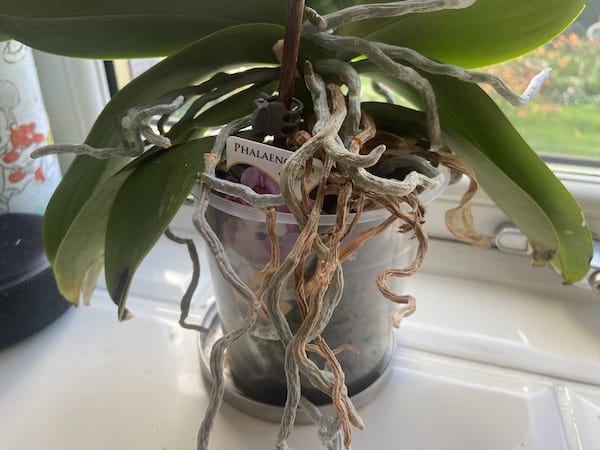
Watering, over- and under-
I’ll start with the most common reason that orchid leaves turn yellow – your watering regime. You may be over-watering or under-watering. Only you can tell which is the problem as both have almost the same effect on your plant – yellow leaves.
Overwatering and letting your plant’s roots become waterlogged prevents oxygen from reaching the roots. The roots can’t breathe; they shut down and stop delivering water and nutrients to the rest of the plant. The leaves turn yellow and become dry because of this.
Underwatering means that the leaves don’t receive enough moisture as the roots are dying. And so the leaves turn yellow and curl up to conserve water.
If you catch the overwatering early enough, the yellow leaves may be restored to green again. But, likely, they’ll just die, and the plant will focus on new growth.
What to do
If you decide that you’ve overwatered your plant, please check the roots thoroughly. Maybe your orchid’s been sitting in water – that is, the potting mix is waterlogged – and so it may have contracted root rot. If some or all of the roots are brown and squishy, your plant does have this problem. Remove the affected roots. For more information about this, see Preventing and treating orchid root rot.
Also, increase the number or size of drainage holes in the orchid pot to make sure that excess water drains out fully and freely.
If you’ve underwatered your orchid plant, then water it thoroughly now. How and when to water my orchid gives information about how to do this as well as details about how to establish a healthy watering schedule.
Too much direct light
Orchids in the home need indirect sunlight, between six and twelve hours per day. If they’re exposed to direct sunlight, especially around the midday hours, the leaves and flowers can burn and turn yellow. If the leaves are still plump but have turned from green to yellow, that’s a sign of too much light. Too much light also causes white spots surrounded by brown and yellow on the leaves.
What to do
Move your orchid to a location that’s sheltered from direct sunlight yet still receives the necessary amount of indirect sunlight.
Too little light
On the other hand, too little exposure to indirect sunlight results in yellow leaves. The orchid doesn’t receive enough sunlight for the amount of photosynthesis needed to produce the chlorophyll for fully green leaves.
What to do
Increase the amount of indirect sunlight that the orchid receives and all will be well.
Wrong temperature
Orchids originally come from the tropics. And the varieties that we buy for our homes still retain the need for a warm climate. Cold temperatures can turn the leaves yellow. Is your orchid in an environment that’s 18°C – 29°C in the daytime and 16°C – 18°C at night? Orchids also need to be out of any draft or breeze as they don’t tolerate changes in temperature, especially growing colder, very well.
What to do
Relocate your orchid to a warmer place out of any drafts.
Wrong fertiliser
Just as orchids can’t grow in regular potting soil, they can’t be fed with regular houseplant fertiliser. Normal fertiliser burns the roots and turns the leaves yellow. The burned roots can’t transport water and nutrients to the rest of the plant, and so the leaves turn yellow.
What to do
Always use a fertiliser created especially for orchids. Follow the instructions on the box or bag and fertilise sparingly.
Transplant shock
Your orchid needs time to adjust after you transplant or repot it. It’s in a new pot with a new orchid potting mix, and its roots are not yet securely fastened to the mix. It’s a bit of a shock. And if you move it to a new location, that’s more for it to deal with. The leaves turn yellow as the plant is not yet functioning properly again.
What to do
Give your orchid time to settle down in these new conditions. See How to grow and care for your orchid to make sure that you have it in the best environmental conditions for its good health, and that you’re caring for it in the correct way.
Pests and diseases
Pests, especially insects that suck the sap out of the orchid’s leaves, can cause the leaves to turn yellow. I have a whole article, Orchid pests and diseases, that includes scale insects and thrips, with information on how to recognise them and how to control them. Please visit there if your orchid is in the right environmental conditions and the problem of yellow leaves has to be from elsewhere.
There are several fungal diseases that affect orchids. The same article, Orchid pests and diseases, is the one to visit if you notice strange splotches on your leaves or a clear sticky substance with black powder. And please go to this article and look up root rot if your orchid’s problem was that you overwatered it.
What to do
The first step is to separate the infected orchid from your other plants. And then to follow the instructions in the article discussed above.
